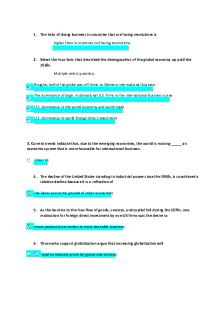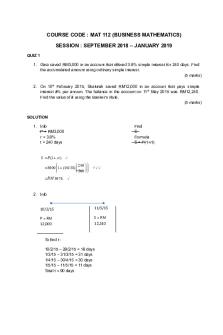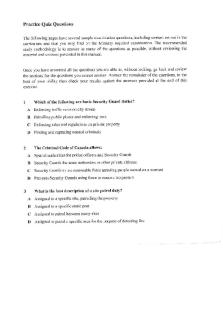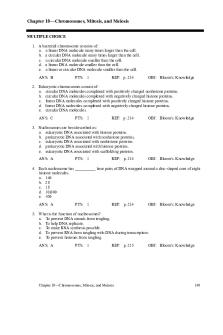Pharm quiz 1 - good practice PDF

| Title | Pharm quiz 1 - good practice |
|---|---|
| Author | Tracy Tran |
| Course | Pharmacology |
| Institution | West Coast University |
| Pages | 15 |
| File Size | 244.2 KB |
| File Type | |
| Total Downloads | 119 |
| Total Views | 181 |
Summary
good practice...
Description
Nursing 180 Pharmacology Week 1 • Objectives 1. Discuss the prototype approach to drug classification. 2. Distinguish between a drug’s chemical name, generic name, and trade name. 3. Explain the meaning of a controlled substance. 4. Describe the roles and responsibilities of the nurse administering medication. 5. Give specific examples of how the nurse can increase patient compliance in taking medication. 6. Identify the four components of pharmacokinetics. 7. Discuss factors affecting drug absorption. 8. Discuss how drugs are distributed throughout the body. 9. Identify major processes by which drugs are excreted. 10. Explain how enterohepatic circulation might affect drug activity. 11. Differentiate between loading and maintenance dose. 12. Discuss principles of pharmacodynamics and how they are applied to clinical practice. 13. Compare and contrast the terms potency and efficacy. 14. Distinguish between agonist, partial agonist, and antagonist. 15. Explain the relationship between receptors and drug action. 16. Explain how physical, cognitive, and psychomotor development influences pharmacotherapeutics. 17. Match the five pregnancy categories with their definitions. 18. Teach a breastfeeding mother about prescription and OTC drugs, as well as the use of herbal products. 19. Describe physiological and biochemical changes that occur in the older adult, and how this affect pharmacotherapy. 20. Describe how nurse practice acts are designed to protect the public. 21. Explain the importance of documentation in the administration of medication. 22. Describe the strategies that the nurse may implement to prevent medication errors. 23. Explain how ethnicity can affect pharmacotherapeutic outcomes. 24. Explain how community and environmental factors can affect health care outcomes. 25. Identify how cultural values and beliefs can influence pharmacotherapeutic outcomes. 26. Explain the role of complementary and alternative medicine in patient wellness. 27. Describe some adverse effects that may be caused by herbal preparations.
• •
Introduction to Drugs and Drug therapy Pharmacology Pharmacology is the application of drugs for the purpose of disease prevention and treatment. The goal of pharmacology is to relieve human suffering.
Although drugs are useful and effective, they are chemicals and can be problematic or even deadly • Non-pharmacologic interventions should always be considered first. Remember drugs are chemical agents that create physiologic changes. Called a “medication” once administered. • Desirable response – therapeutic effect • Undesirable – adverse/side effect or complication Understanding Pharmacology An extensive field of study • How drugs are administered • Where they travel in the body • Responses that drugs produce To understand pharmacology, you MUST understand • Anatomy and Physiology • Chemistry • Microbiology • Pathophysiology • And much more! Nurses who know pharmacology • Provide safe and effective treatment • Coordinate better care • Practice within legal guidelines • Participate in the approval process especially during post marketing surveillance Challenges More than 10,000 drugs available with their own characteristics Many drugs are used for more than one disease Many drugs are used when a drug reference indicates the drug may be contraindicated or used with caution Drugs elicit different responses depending on • Age • Sex • Body mass • Genetics – be cautious with all drugs and observe for individual responses; genetics are not always obvious Nurses are on the frontline • Knowledge is essential • Nurses are the health care providers most directly involved in patient care • Learning about drugs never stops Why Be Knowledgeable? Positive patient outcomes The nurse is legally responsible for his/her own practice in giving drugs safely Safety failures can harm or kill the patient What is a Drug? Any substance used in the ____ of disease • Prevention • Diagnosis • Alleviation • Treatment • Cure • What drugs are you taking? •
•
•
•
•
• • • •
•
• • • •
• What answers might you get? • What might the patient think? Drug Sources • •
• • • • • • • • • • • • •
Plants • Atropine (belladonna), caffeine (coffee), nicotine (tobacco) Animals • Conjugated estrogens (Premarin), old sources of insulin, heparin, some vaccines Minerals • Salicylic acid, aluminum hydroxide (antacids), sodium chloride (salt, saline) Laboratory synthesis • Current insulin Pharmacoeconomics may be affected by source • Cost-benefit analysis of using the drug Types of Drugs Prescriptive Non-prescriptive or “over-the-counter” (OTC) Vitamins Herbal supplements Alcohol Cigarettes Heroin, marijuana, etc… All of these drugs can interact Classification or Indication • Drug class is based on what the drug does in the body. • ACE Inhibitor • Loop Diuretic • Beta Blocker
Indication is based on what a drug does • Anticoagulant • Antidepressant • Antineoplastic • Many drugs do more than one thing Drug Names Chemical name • The drug’s chemical composition and molecular structure • (+/-)-2-(p-isobutylphenyl) propionic acid • Some groups may be classified by a chemical group name Generic name (nonproprietary name) – used by health care industry • Name given by the United States Adopted Name Council • ibuprofen (written using lower case) Trade name (proprietary name, product name, or brand name) – often used by patients • The drug has a registered trademark; use of the name restricted by the drug’s owner (usually the manufacturer) • Manufacturer maintains exclusive rights for 17 years (expensive) • Motrin (capitalized) • How Does a Drug Become a Drug? • Preclinical investigation • Short and long term 1-10 years • Clinical investigation (evaluates human benefit) •
• • • • • • • • • • • •
• • • • •
• • •
• • • •
• Trials I, II, & III 2-10 years Review of new drug application • 2 mos. – 7 years Post marketing surveillance • Drug is now being used. Goal – safety Result - expense To be a Model “Prototype” Drug Well understood Known action and adverse effects Used to compare other drugs in the same pharmacologic class May not be the most widely used drug in its class Ex: Our prototype for opioids will be morphine-we will take what we learn about morphine and apply it to the other drugs in its drug class (opioids). Disagreements may exist over which drug should serve as the prototype Newer drugs may replace the prototype • More effective • More favorable safety profile • Longer duration of action Prescriptions Each facility has its own regulatory process for prescriptions including who may write, receive, and transcribe them. Verbal prescriptions should only be taken in an emergency situation. Types: Routine/Standing, Single/One-Time, STAT, PRN Components • Name of the client • Date and time of prescription • Name of the drug, strength and dosage • Route of Administration • Time and frequency of administration (exact times or number of times/day) • Quantity to dispense and number of refills • Signature of the provider Prescription Versus OTC Prescriptive Advantages • Health care provider examines patient and orders proper drug • Amount and frequency controlled • Instructions on use and SE discussed Disadvantages • Require a prescription to obtain • Need for PCP appointment OTC Advantages • No appointment necessary • Less expensive than RX drugs Disadvantages • May choose wrong drug • May not follow guidelines • May not know reactions or interactions • Ineffective treatment may result in progression of disease
• • • • •
• • • • • • • • • • • • •
• • • a) b) c) d) • • • • •
• See Pg. 16 of text for OTC considerations for patients. Addiction, Dependence, and Abuse Drug misuse • Using the drug outside of its intended purpose Drug abuse • Repeatedly using the drug outside of its intended purpose and often outside of the prescribed or indicated dosage. Abuse, Addiction, and Dependence Physical dependence • An altered physical condition caused by the adaptation of the nervous system to the repeated drug use • When drug is no longer available, the individual expresses physical signs of discomfort know as withdrawal (can be life threatening) Psychological dependence • Little physical discomfort when drug is withdrawn, but intense compelling desire to continue use Addiction is characterized by an intense “craving” for the drug Controlled Substances Stimulants & Depressants Nicotine Cocaine Caffeine Amphetamines Alcohol Sedative/hypnotics Cannabis Inhalants Special Needs of Drug Abuse Clients Abstinence Syndrome: May occur when clients abruptly withdraw from a substance to which they are physically dependent. The client may experience distressing manifestations (GI distress, neurologic/behavioral change, CV changes, seizures) that can lead to coma and death. Severity of withdrawal varies depending on the substance. Tolerance: increased amounts of the substance are needed to achieve the desired effect (can occur in non-drug abuse clients as well). Pregnancy Safety Categories Quick question Which of the following statements best describes an advantage of prescription drugs over OTC medications? OTC drugs do not require a physician’s order. Prescription medications ensure that harmful reactions will not occur. Only patients authorized to receive prescription drugs will take these medications. The nurse can maximize therapy by ordering the amount and frequency to be given. Pharmaceutics, Pharmacokinetics & pharmacodynamics Making Change Happen Pharmaceutics The study of how various drug forms influence pharmacokinetic and pharmacodynamic activities “Pharmaceutic phase” of drug action
Note that drugs must be in solution before absorbed in the gastrointestinal (GI) tract • “Disintegration” is the breakdown of a tablet into smaller particles • “Dissolution” is the dissolving of the smaller particles in GI fluid prior to absorption. • These processes may be affected by different drug coatings (extended release, slow release, etc)-DO NOT CRUSH OR CHEW • XR, ER, SR, XL, etc • PHarmaceutics • Not all tablets are 100% drug. • Fillers and excipients are used in drug preparation to allow the drug to take on a particular size and shape and to enhance the dissolution process • Examples: simple syrup, vegetable gums, aromatic powders, honey, etc. • Pharmacokinetics • How drugs move and travel through the body. • Four Phases of Pharmacokinetics: • Absorption • Distribution • Metabolism • Excretion • Absorption • Movement of drug particles from the location of administration to the bloodstream. • Most common routes are enteral (GI) and parenteral (injection). • Affected by the rate of absorption by the body, the amount of drug given, and the route. • Enteral Absorption • Drug is absorbed into the systemic circulation through the oral or gastric mucosa, the small intestine, or rectum. • Oral (PO) – by mouth • Varies greatly due to: solubility of the medication, GI pH and emptying time, presence of food, other medications given, forms of medication • Sublingual (SL) – placed under the tongue, rapid absorption • Buccal – in contact with surface of the cheek • NG/GT/PEG -- Administration via a tube into the enteral mucosa. • Rates of Absorption Oral Preparations Liquids, elixirs, syrups Fastest Suspension solutions ê Powders ê Capsules ê Tablets ê Coated tablets ê Enteric-coated tablets Slowest • Topical Routes • Benefit is highly targeted to specific area • Skin: powders, creams, sprays, ointments, lotions, pastes, patches • Eyes: ophthalmic drops • Ears: otic drops • Nose: nasal sprays • Rectal/Vaginal: suppositories and creams • Lungs: MDI/DPI/Nebulizer •
• • • •
•
• • • • • • • • • • • • •
• •
• • • •
Other Absorption Facts Low-molecular weight drugs diffuse across a cell more easily that high weights Lipid soluble drugs and non-ionized are absorbed faster than ionized drugs Some drugs need an acidic environment to be absorbed • Food intake can help absorption of some drugs by stimulating the proton pump of stomach-more acid produced • Many drugs prefer an alkaline environment and may be coated to outlast stomach acid and dissolve in the small intestine for absorption. • First Pass Effect Metabolism of a drug and passage from the liver into the circulation. • A drug given via the oral route may be extensively metabolized by the liver before reaching the systemic circulation (high first-pass effect). • The same drug—given “IV”—by passes the liver, preventing the first-pass effect from taking place, and more drug reaches the circulation. Routes that Bypass the Liver Reduced First Pass Effect Sublingual Buccal Rectal – undergoes a higher first-pass effect than others listed Intravenous Intranasal Transdermal Vaginal Intramuscular Subcutaneous Inhalation Pharmacokinetics : Distribution Transport of a drug in the body by the bloodstream to its site of action • Protein-binding • Blood-brain barrier • Areas of rapid distribution: heart, liver, kidneys, brain (poor circulation can have an effect) • Areas of slow distribution: muscle, skin, fat Protein-Binding Binding of drugs to plasma proteins in the body (ex. Albumin) • “Bound” drug is an inactive drug • Binding of drugs to protein reduces “free” drug • “Free” drug molecules are released into circulation and can attach to drug receptors • “Free” drug is the portion of the drug that creates pharmacologic effect. Importance of Protein Binding Protein binding directly affects distribution of the drug Patients with less body protein stores will be greatly affected (malnourished, etc.)these patient will be at risk for drug toxicity due to a high concentration of “free” drug. Two highly protein bound drugs can compete for receptors and cause drug interactions
• • • • • • • • • • • •
• • • • • •
• • • • • • • • •
• •
• Affects pharmacodynamics of the drug (how well it works) • Affects metabolism (breakdown) of the drug Blood Brain barrier Blood vessels in the brain have cells that are tightly pressed together. This protects the brain from foreign substances (this includes drugs). Drugs that are highly lipid soluble and of low molecular weight can cross the BBB. However, drugs that are water soluble and that cannot bind to a protein carrier can’t cross the BBB. EX: Chemotherapy does not cross the BBB easily, making surgery and radiation therapy the go to treatment for many cancers of the brain. Metabolism-It’s Here, Now How Do We Get Rid of It Also known as biotransformation. Medication is changed to less active or inactive forms primarily by enzymes. Occurs primarily in the liver. Decreased in infants and older adults Decreased in those in liver failure, those with hepatitis, cirrhosis, etc. • These patients may require lower dosages, less frequent dosing, close monitoring for complications, monitor LFT’s (AST/ALT) closely, monitor for drugs that are hepatotoxic Other medications may mess with metabolism of another medication. First-Pass Effect Outcomes of Metabolism Increased renal excretion (most excretion occurs here-impaired renal function may delay the process) Inactivation of the medication Increased therapeutic effect • Activation of pro-medications (pro-drugs) into active forms • Ex: Codeine is a pro-drug and is converted to morphine in the liver (less toxic than morphine for those at high risk) Decreased toxicity as the drug becomes inactive Increased toxicity when inactive forms of medications become more active forms Half-Life It usually takes 4 half-lives to achieve a steady blood concentration, or steady state. Steady state means medication intake=medication metabolism and excretion. Half-life helps us make dosing decisions-long half-life=less frequent dosing, short half-life=more frequent dosing Bioavailability & Bioequivalence Bioavailability is the amount of drug available to create change in the body. Because of first pass metabolism and absorption issues, oral drugs do not have high bioavailability. Bioequivalence means that drugs have the same rate and extent of absorption. • Example: It is optimal to have a brand name drug and generic formulation bioequivalent for marketing. Brand name, Advil, should be the same as generic ibuprofen • However, due to the presence of fillers, this is not always the case. • If there is less than 20% variance in a generic and a trade drug, the generic is considered “therapeutically equivalent” to the trade drug. • Loading Dose A large dose of drug that is significantly higher than the usual “maintenance” dose. Used to help achieve the therapeutic effect of the drug more quickly.
• • • • • •
• • •
• • • •
• • • • • • • •
This dose is not given repeatedly as it would produce toxic effects. Ex: “Z-Pack”, two tablets the first day, followed by a lower dose over the next several days. Drug excretion The elimination of drugs from the body. Primarily done by the kidneys but some drugs are excreted through the GI system, liver, lungs, and exocrine glands. Kidney dysfunction can lead to an increase in duration and intensity of a medication’s response (kidney failure). • May need less frequent dosing, smaller doses, more frequent monitoring for complications, monitoring for drugs that are nephrotoxic, monitor kidney function (BUN, Creatinine, eGFR) PHarmacodynamics The study of effects of drugs on the body. Dose-Response Curve: comparison of the body’s response to changes in drug concentration at the site of action. • Potency: amount of drug needed to elicit a specific response to a drug. • Highly potent drugs produce significant responses at low concentrations (they are also more likely to cause side effects/complications!) • Efficacy: how well the drug produces the intended changes within the body Onset: The time it takes for a drug to begin to take effect. Duration: The length of time the drug exerts therapeutic effects. PHarmacodynamics Therapeutic Index: The difference between a drug’s likelihood to produce the therapeutic effect and its likelihood to produce toxic responses. • Drugs with a high TI have a wide safety margin and don’t require blood medication level monitoring (Peaks and Troughs) • Drugs with a low TI require close medication level monitoring • Peak level: highest plasma level of the drug (usually 2-3 hours for oral medications, much faster for IV medications (usually 30 min-1hr), follow pharmacy guidelines) • Trough level: lowest plasma level of the drug (obtained immediately before the next dose. Therapeutic Range: a range of doses that produce a therapeutic response without causing significant adverse effects in patients. Pharmacodynamics Drugs act by binding to receptors. The drug may activate the receptor, creating a response. They may also block the receptor, blocking a response. Certain drugs have an affinity for certain receptors in the body meaning that they are likely to bind those particular receptors. Drugs that affect multiple receptor sites are considered non-specific and nonselective. Pharmacodynamics Complications, or side effects, are secondary effects of drug therapy. All drugs have complications. They range from inconvenient to life-threatening. • It is important for the nurse to include teaching for patients on how to manage these complications and when to report them as many can be managed with dosage adjustment or changing the medication.
• • • • • • • • • • • • • • • • • •
• • • • • • • •
Adverse Effects: Unintentional, unexpected reactions to drug therapy that occur at normal drug dosages. These events must be reported and documented (ex: anaphylaxis) however your first responsibility is to assess the patient. Toxic Effects: Occur when drug levels exceed the therapeutic range; can occur due to overdose (unintentional or intentional) or drug accumulation due to prolonged therapy or poor metabolism/excretion. Drug Interactions Drug interactions can be drug-drug, drug-nutrient (food, alcohol, supplements), drug-disease, or drug-laboratory in nature. Those with chronic hea...
Similar Free PDFs

Pharm quiz 1 - good practice
- 15 Pages

Pharm 1 Quiz 1 Review
- 18 Pages

Pharm Quiz 6
- 1 Pages

Pharm practice A
- 9 Pages

Pharm Quiz Reviews
- 21 Pages

Sample Quiz #1 - Practice Quiz
- 2 Pages

Patho Practice Quiz 1
- 5 Pages

Chapter 1 - quiz practice
- 5 Pages

HW 1 - Quiz Practice
- 7 Pages

Practice Quiz 1
- 2 Pages

QUIZ 1 MAT112 Practice
- 2 Pages

Practice Quiz 1 - Exam
- 24 Pages

Practice Quiz 1
- 11 Pages

Pharm Hesi Practice Q&A
- 5 Pages

Ch 10 - GOOD PRACTICE
- 15 Pages
Popular Institutions
- Tinajero National High School - Annex
- Politeknik Caltex Riau
- Yokohama City University
- SGT University
- University of Al-Qadisiyah
- Divine Word College of Vigan
- Techniek College Rotterdam
- Universidade de Santiago
- Universiti Teknologi MARA Cawangan Johor Kampus Pasir Gudang
- Poltekkes Kemenkes Yogyakarta
- Baguio City National High School
- Colegio san marcos
- preparatoria uno
- Centro de Bachillerato Tecnológico Industrial y de Servicios No. 107
- Dalian Maritime University
- Quang Trung Secondary School
- Colegio Tecnológico en Informática
- Corporación Regional de Educación Superior
- Grupo CEDVA
- Dar Al Uloom University
- Centro de Estudios Preuniversitarios de la Universidad Nacional de Ingeniería
- 上智大学
- Aakash International School, Nuna Majara
- San Felipe Neri Catholic School
- Kang Chiao International School - New Taipei City
- Misamis Occidental National High School
- Institución Educativa Escuela Normal Juan Ladrilleros
- Kolehiyo ng Pantukan
- Batanes State College
- Instituto Continental
- Sekolah Menengah Kejuruan Kesehatan Kaltara (Tarakan)
- Colegio de La Inmaculada Concepcion - Cebu
